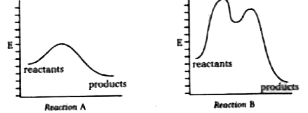In which statement is true ?
Reaction A+B→Q is faster.
Reaction Q→C is faster.
Reaction in (a) and (b) are equal.
Unpredictable.
The correct Answer is:B
To solve the question regarding the activation energy in a multi-step reaction and determine which statement is true, we can follow these steps:
1. Identify the Reactions:
We have two reactions:
- Reaction 1: A+B→Q
- Reaction 2: Q→C
2. Understand Activation Energy:
Activation energy (Ea) is the minimum energy required for a reaction to occur. It can be visualized as the height of the energy barrier that the reactants must overcome.
3. Analyze the Potential Energy Diagram:
From the video transcript, we know that:
- The total energy for the formation of Q from A+B is 25 kcal/mol.
- The energy level of Q is at 7 kcal/mol.
- The energy level of C is at 20 kcal/mol.
4. Calculate Activation Energy for Each Reaction:
- For Reaction 1 (A+B→Q):
EaA+B→Q=Total Energy−Energy of Q=25 kcal/mol−7 kcal/mol=18 kcal/mol
- For Reaction 2 (Q→C):
EaQ→C=Energy of C−Energy of Q=20 kcal/mol−7 kcal/mol=3 kcal/mol
5. Compare Activation Energies:
- EaA+B→Q=18 kcal/mol
- EaQ→C=3 kcal/mol
Since 18 kcal/mol>3 kcal/mol, the activation energy for the first reaction is greater than that for the second reaction.
6. Determine Reaction Rates:
According to the principle that lower activation energy leads to a faster reaction, we conclude:
- The reaction Q→C is faster than A+B→Q.
7. Select the True Statement:
The correct statement is that the reaction Q→C is faster than A+B→Q.
Final Answer:
The true statement is: "The reaction Q→C is faster than A+B→Q."
We have two reactions:
- Reaction 1: A+B→Q
- Reaction 2: Q→C
Activation energy (Ea) is the minimum energy required for a reaction to occur. It can be visualized as the height of the energy barrier that the reactants must overcome.
From the video transcript, we know that:
- The total energy for the formation of Q from A+B is 25 kcal/mol.
- The energy level of Q is at 7 kcal/mol.
- The energy level of C is at 20 kcal/mol.
- For Reaction 1 (A+B→Q):
EaA+B→Q=Total Energy−Energy of Q=25 kcal/mol−7 kcal/mol=18 kcal/mol
EaQ→C=Energy of C−Energy of Q=20 kcal/mol−7 kcal/mol=3 kcal/mol
- EaA+B→Q=18 kcal/mol
- EaQ→C=3 kcal/mol
According to the principle that lower activation energy leads to a faster reaction, we conclude:
- The reaction Q→C is faster than A+B→Q.
The correct statement is that the reaction Q→C is faster than A+B→Q.
The true statement is: "The reaction Q→C is faster than A+B→Q."
Topper's Solved these Questions
- CHEMICAL KINETICSBOOK - CENGAGE CHEMISTRY ENGLISHCHAPTER - CHEMICAL KINETICSEXERCISE - Exercises Assertion-Reasoning
22 Videos
- CHEMICAL KINETICSBOOK - CENGAGE CHEMISTRY ENGLISHCHAPTER - CHEMICAL KINETICSEXERCISE - Exercises Integer
15 Videos
- CHEMICAL KINETICSBOOK - CENGAGE CHEMISTRY ENGLISHCHAPTER - CHEMICAL KINETICSEXERCISE - Exercises Multiple Correct
33 Videos
- CARBOXYLIC ACIDS AND THEIR DERIVATIVESBOOK - CENGAGE CHEMISTRY ENGLISHCHAPTER - CARBOXYLIC ACIDS AND THEIR DERIVATIVESEXERCISE - Exercises Archives (Analytical And Descriptive)
34 Videos
- COORDINATION COMPOUNDSBOOK - CENGAGE CHEMISTRY ENGLISHCHAPTER - COORDINATION COMPOUNDSEXERCISE - Archives Subjective
18 Videos
Similar Questions
Knowledge Check
If p(x) is a polynomial function and p(4)=0, then which statement is true?
Ax+4 is a factor of p(x)Bx-4 is a factor of p(x)CThe greatest power of x in p(x) is 4.Dp(x) is divisible by 4.For the following two reactions, which statement is true ?
 AReaction A is faster and less exergonic than BBReaction B is faster and more exergonic than ACReaction A is faster and less endergonic than BDReaction B is faster and more endergonic than A
AReaction A is faster and less exergonic than BBReaction B is faster and more exergonic than ACReaction A is faster and less endergonic than BDReaction B is faster and more endergonic than AIf p(x) is a polynomial function and p(-1)=3, which statement is true?
AThe remainder when p(x) is divided by x-3 is -1.BThe remainder when p(x) is divided by x+3 is -1.CThe remainder when p(x) is divided by x-1 is 3.DThe remainder when p(x) is divided by x+1 by 3.
